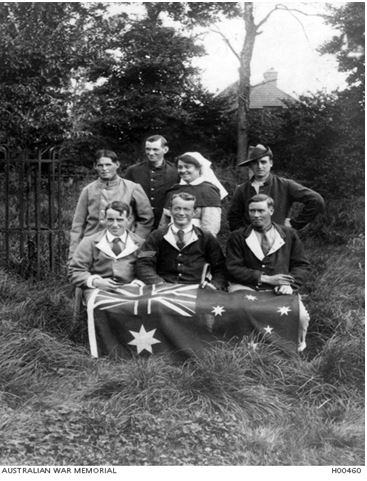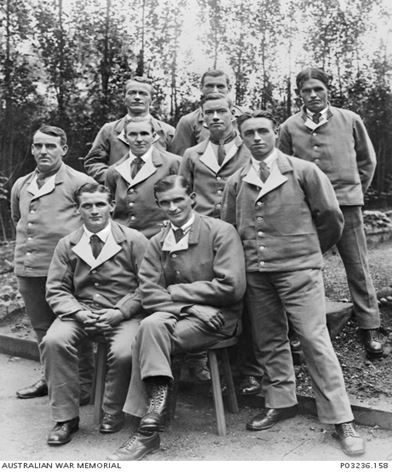Arnold Thorp
From Our Contribution
 Repatriated Prisoners in English hospital grounds -Arnold standing left side of rear row. | |
 Ex POWs in hospital issued rehabilitation uniforms - Arnold standing right side of rear row. | |
| Personal Information | |
|---|---|
| Date of Birth | 22 Oct 1891 |
| Place of Birth | Fremantle, Western Australia |
| Death | 16 Jun 1960 |
| Age at Enlistment | 23 years, 5 months |
| Description |
5'6¾" (1.70m) tall ; 126lbs 57.153 kg ; mid dark complexion ; grey eyes ; dark brown hair ; Flags tattoo on chest, tattoos both arms |
| Occupation | Bricklayer |
| Religion | Methodist |
| Address | Maddington, Western Australia |
| Next of Kin | Father , Mr Albert Thorp |
| Military Information | |
| Reg Number | 538 |
| Date of Enlistment | 8 Mar 1915 |
| Rank | Private |
| Unit/Formation | 28th Battalion, C Company |
| Date of Embarkation | 9 Jun 1915 ‒ 2 Jul 1915 |
| Ship Embarked On | HMAT A11 Ascanius |
| Date of Return | 8 Apr 1918 ‒ ?? Apr 1918 |
| Ship Returned On | HMHS Dunluce Castle England to Egypt |
| Date of Return | 12 Jul 1918 ‒ 17 Aug 1918 |
| Ship Returned On | SS Port Darwin Suez to Sydney |
| Fate |
WIA 29 Jul 1916 Pozières POW 29 Jul 1916 Repatriated via Switzerland Returned to Australia |
| Monument |
Gosnells Road Board Honour Roll name misspelt The Australian Ex-Prisoners of War Memorial Ballarat, Victoria |
| Medals |
1914-15 Star British War Medal Victory Medal |
Contents
[hide]Pre War
Address was Suffolk street, Fremantle. NOK lived in Maddington.
War Service
Arnold entered Blackboy Hill camp on 8 Mar 1915 and a week later was allocated to the 28th Battalion where he was posted to 'C' Company. He travelled to Egypt with them aboard HMAT A11 Ascanius and then on via Alexandria for Gallipoli aboard the HMT Ivernia on 4 Sep 1915. Following the evacuation of Gallipoli they returned first to Mudros aboard HMT Osmanieh, disembarking on 14 Dec 1915 and then from Mudros to Alexandria on HMT Ausonia, disembarking on 10 Jan 1916.
On 16 Mar 1916 the battalion boarded HMAT A32 Themistocles in Alexandria harbour for Marseilles in southern France, where they arrived at 3:30pm on 21 Mar 1916. They disembarked the following morning and set off by train in cattle trucks on a 57 hour journey to Morbecque in northern France. Despite the snow they then then marched 10 miles to their billets which were canvas tents in a muddy field near Hazebrouck. The food awaiting them was cold bully beef. Welcome to France! The next three months were spent circulating in and out of the front lines near Armentières. On 5 Jun 1916 the 28th Battalion participated in the first Australian raid on enemy trenches in France before after which they moved north into the Messines area on 17 Jun 1916.
On 26 Jul 1916 Arnold was charged with being in Amiens on 19 Jul 1916 without a pass. No doubt in search of hot food amongst other things. Awarded 48 hours Field Punishment No. 2 (see notes). With the commencement of a major attack on the Somme on 1 Jul 1916 it was not long before the 28th Battalion was told to be ready to move south. This they did on 12 Jul 1916, to Bertangles where they remained training for 5 days. The troops of the 1st Division had captured the township of Pozières and held it despite an enormous German artillery barrage. On 26 Jul 1916 the 2nd Division began to move up, and during the night of 28/29th July were to attack OG1 and OG2 trenches and capture the Windmill position to the north of Pozières. However, when they advanced they found unbroken wire blocking their attack, and the first two waves of the attack were mown down by machinegun fire. Eventually the survivors withdrew to their earlier positions.
Arnold was reported missing on 29 Jul 1916. Later authorities were advised that he was a Prisoner of War, having received a wound to his upper left thigh, and had been captured at Pozières. Following treatment by a German Lazaret on 12 Dec 1916 he was held at Munster before being transferred to Constance in Switzerland on 14 Dec 1916, deemed to not being able to return to the battlefield. In Switzerland he received further treatment for his wounds, before being sent back to England, where on 14 Sep 1917 he was admitted to the 1st London General Hospital. His wound was said to have been caused by shrapnel, resulting in a compound fracture of his femur and therefore it was having trouble healing. On 15 Sep 1917 he was transferred to the 1st Australian Auxiliary Hospital. He was then granted special furlough from 22 Sep until 20 Oct 1917, after which he reported to the No 2 Command Depot in Weymouth.
On 11 Dec 1917 he was admitted to the 1st Australian Dermatological Hospital at Bulford where he received treatment for Venereal Disease for 10 days. On 12 Mar 1918 he was transferred to the No 1 Command Depot at Sutton Veny, but 3 days later required hospital treatment as his wound was still not healed satisfactorily. On 23 Mar 1918 he was transferred to the 1st Australian Auxiliary Hospital at Harefield, remaining with them until he shipped home on a hospital ship on 8 Apr 1918.
On arrival in Australia he was sent to the 8th Australian General Hospital at Fremantle, and while receiving treatment he was on six occasions either AWOL or late back from leave between 5 Oct 1918 and 3 Mar 1919 with penalties totaling 21 days pay plus 5/-. Arnold was discharged by the 5th Military District on 29 Apr 1919.
Post War
No marriage or death recorded in WA BDMs
Notes
Field punishment could be awarded by a court martial or a commanding officer for any offence committed on active service.
There were two categories of field punishment. Field punishment No. 2 consisted of heavy labouring duties. All offenders awarded field punishment would march with their unit, carry their arms and accoutrements, perform all their military duties as well as extra fatigue duties, and be treated as defaulters.